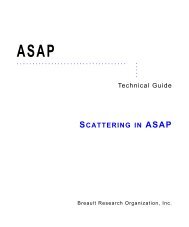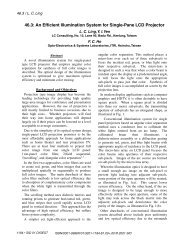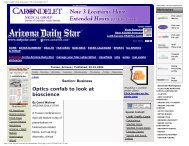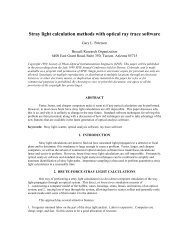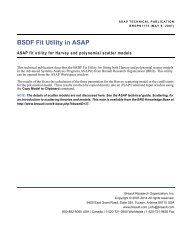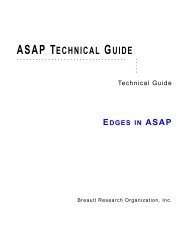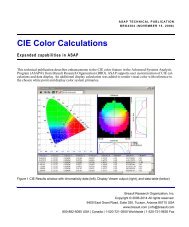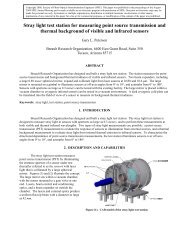diffraction gratings and does - Breault Research Organization, Inc.
diffraction gratings and does - Breault Research Organization, Inc.
diffraction gratings and does - Breault Research Organization, Inc.
Create successful ePaper yourself
Turn your PDF publications into a flip-book with our unique Google optimized e-Paper software.
DIFFRACTION GRATINGS AND DOESFundamentals of Diffractive Optical Elements. . . . .dimensional <strong>diffraction</strong> grating. It can also be regarded as a three-dimensionalinterference filter.A volume hologram has a thickness that is much greater than the thickness of itsthin holographic counterpart. Even then, it is still very thin, perhaps on the order oftens of microns. The larger thickness is needed to record the three-dimensionalfringe pattern. The thicker the volume hologram, the more light is diffracted intothe first order. In fact, efficiencies of 100% are achievable.Volume holograms de-couple wavelength <strong>and</strong> the <strong>diffraction</strong> angle. In other words,only a specific wavelength is diffracted at a specific angle in the hologram.Because of this property, you can store many holograms at one time. Just changethe incident wavelength. Similarly, you can change the angle of incidence toachieve the same effect.Volume holograms are highly susceptible to shrinkage. Therefore, if shrinkage isnot accounted for, the replay wavelength must be shorter than the recordingwavelength. Only at special wavelengths is light diffracted at a particular angle. Inthis sense, the volume hologram acts like a spectral filter.ASAP can simulate volume holograms, but it <strong>does</strong> so using the grating equation.However, we must set up appropriate <strong>diffraction</strong> efficiency models with theCOATING MODELS option in ASAP, <strong>and</strong> specifically use the interface diffractoption with this coating model.ASAP simulates volume holograms as thin holograms with appropriately adjusted<strong>diffraction</strong> efficiencies. Most other lens design codes also use this technique.However, they sometimes include approximated <strong>diffraction</strong> efficiency calculationsfrom, for example, Kogelnik’s theory (Bell Systems’ Technical Journal, 48, 2909,1969). This simulation technique assumes that the primary difference betweenvolume <strong>and</strong> surface holograms is the behavior of the <strong>diffraction</strong> efficiencies.ASAP Technical Guide 33



